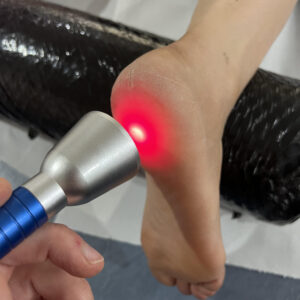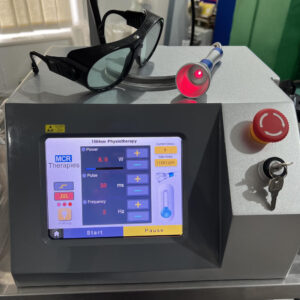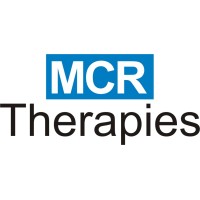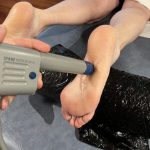High-Intensity Laser Therapy: A Potent Treatment
In today’s world, where medical breakthroughs are continuous, it is vital to investigate alternative Laser Therapy choices that can provide safe and effective answers for various medical ailments.
There has been a lot of buzz about high-intensity laser therapy as a potential alternative recently. Pain management, skin issues, neurological diseases, sports injuries, and even dentistry have all shown promise with this non-invasive therapy.
This article thoroughly covers laser treatment, its benefits, and its potential impact on healthcare. Another name for laser therapy is photobiomodulation, which uses light to enhance healing by stimulating cellular activity. The treatment uses the specific wavelengths of light emitted by lasers.
Key Takeaways
- High-Intensity Laser Therapy is a powerful treatment option that can be used for various conditions.
- Laser Therapy stimulates the body’s natural healing processes and reduces inflammation.
- The benefits of Laser Therapy include pain relief, accelerated healing, and improved skin health.
- Laser Therapy is often more effective than traditional treatment methods and has fewer side effects.

High-intensity laser therapy (HILT) is a promising new treatment option for a variety of diseases. It could shake up the healthcare system.
The positive outcomes of HILT in pain management, sports injuries, skin problems, neurological illnesses, and dental applications suggest that it has the potential to become a prevalent and game-changing therapeutic option in the future.
Based on their power levels, these lasers can be categorised into many types, such as low-level and high-intensity lasers. Laser therapy’s scientific basis is its ability to penetrate deeply into tissues and interact with cells.
The cells absorb the laser light, which triggers metabolic responses with several therapeutic effects. These results include enhanced circulation, reduced inflammation, accelerated tissue repair, and enhanced production of cellular energy currency, adenosine triphosphate (ATP). One of the primary benefits of high-intensity laser therapy is its ability to alleviate pain.
Light from a laser can trigger the release of endorphins, which are the body’s painkillers. Mainly, those who have fibromyalgia, arthritis, or persistent back pain may discover this to be a boon.
Not only can laser therapy alleviate pain, but it also decreases inflammation. It can alleviate pain, redness, and swelling caused by conditions like tendinitis, bursitis, and sprains. Enhanced blood flow is yet another advantage of laser treatment.
The laser’s ability to encourage the growth of new blood vessels increases blood flow in the treated area. Better blood flow carries oxygen and nutrients to the cells, speeding up the healing and regeneration processes. It has also been shown that laser therapy speeds up recovery time.
The manufacturing process stimulates the development of collagen, a protein essential for the healing of wounds and other tissues. Because of this, HILT is an excellent choice for patients recovering from surgeries, ulcers, or wounds since it is a non-invasive and safe therapeutic option.
A comforting and confidence-boosting component of HILT is that it does not involve incisions or the intake of medicines, unlike surgical procedures or medication.
As a painless, low-risk treatment option, laser therapy can be used either alone or in combination with other types of therapy. Before deciding to undergo laser therapy, it is important to consider all of the potential risks compared to more traditional medical procedures.
Traditional treatment options, including medications and surgery, have been widely used for decades and have often proven successful. However, there are hazards and adverse effects associated with them.
For example, medicine side effects, addiction, or long-term problems are all possible outcomes. Infection, scars, and prolonged recovery periods are some of the hazards linked with surgery.
On the other hand, laser treatment is a risk-free, non-invasive option that can produce equivalent or superior outcomes. When dealing with discomfort, many people turn to high-intensity laser therapy.
The use of high-intensity laser therapy to alleviate both short-term and long-term injury pain is showing promising outcomes. Arthritis, neuropathy, and sciatica are just some of the diseases that this method effectively treats.
Patients suffering from chronic pain may find some relief from the natural analgesics released when the laser light hits the area, which can drastically reduce pain thresholds.
 Laser treatment is a great way to improve results and speed up the healing process in sports medicine.
Laser treatment is a great way to improve results and speed up the healing process in sports medicine.
Directing a laser beam of light onto the injured region can help with pain, inflammation, and tissue healing. This means athletes can return to training or competing sooner after a setback.
Laser therapy can also be employed as a preventative approach. According to a large body of research, it is an excellent method for treating sports injuries, reducing the likelihood of injuries and improving overall performance.
Athletes who have undergone laser therapy for tendinitis, sprains, or strains have reported significant enhancements to their functional capacities, mobility, and pain thresholds following treatment.
Eczema, psoriasis, and acne are skin conditions that can majorly impact a person’s quality of life and self-esteem. When it comes to rejuvenating and restoring skin health, laser therapy is a novel and encouraging therapeutic option. By focusing the laser light on the affected areas, inflammation is reduced, cellular turnover is accelerated, and collagen synthesis is increased.
This can improve skin texture, reduce redness, and make scars and other imperfections less noticeable. The beneficial effects of laser therapy on skin health extend far beyond its aesthetic benefits.
Laser treatment can alleviate vitiligo and rosacea, among other skin conditions, in addition to skin cancer. It is a non-invasive and effective alternative to improving skin health and regaining self-confidence.
A person’s quality of life can be drastically diminished by neurological disorders such as multiple sclerosis, neuropathy, and stroke.
Potentially helpful for patients, laser therapy has demonstrated promise as a treatment for various conditions. Blocking laser light on the injured regions reduces inflammation, cellular activity is stimulated, and neuroregeneration is encouraged.
This can improve nerve function, alleviate pain, and boost general wellness for people with neurological illnesses. Laser treatment for neurological diseases is still a topic of active research, with promising outcomes.
Clinical trials have shown that laser therapy improves motor function, pain thresholds, and patients’ quality of life. Nevertheless, additional research is required to understand the mechanisms of action and enhance treatment regimens.
Good oral health is essential to overall wellness, and laser therapy has become a valuable resource for dentists. It has many potential dental uses, including treating periodontal disease, teeth whitening, and oral surgery.
Through the targeted application of laser light, it effectively eradicates microorganisms, reduces inflammation, and promotes tissue regeneration. This might lead to better oral hygiene, healthier gums, and less bleeding.
Laser therapy would be beneficial in several dental applications. This precise and less invasive therapy approach can minimise post-operative discomfort, speed healing, and reduce the need for anaesthesia.
When combined with more traditional dental procedures, laser dentistry can yield even better results. In several medical fields, high-intensity laser treatment has shown promising results.
 It is a viable alternative to traditional treatment methods because of its efficacy, safety, and lack of invasiveness. Pain management, skin diseases, neurological issues, sports injuries, and dental use are just a few areas where patients can reap the benefits of laser treatment.
It is a viable alternative to traditional treatment methods because of its efficacy, safety, and lack of invasiveness. Pain management, skin diseases, neurological issues, sports injuries, and dental use are just a few areas where patients can reap the benefits of laser treatment.
As long as scientists keep pushing the boundaries of knowledge, high-intensity laser treatment has a promising future.
As time passes and more is learned about how things work, laser treatment could revolutionise healthcare. Safe and efficient therapies for diverse conditions can improve the quality of life for countless people.
Additional research into treatment strategies, novel uses, and long-term effects is necessary to realise the full potential of high-intensity laser treatment.
Further research into this area could lead to laser treatment becoming a regular treatment option, which would profoundly impact healthcare.
To delve deeper into the topic, click Laser Therapy for Pain Management.
HILT FAQs
What is High Intensity Laser Therapy?
High-intensity Laser Treatment (HILT) is a non-invasive medical procedure that uses high-powered lasers to stimulate healing and reduce pain in damaged tissues.
How does High Intensity Laser Treatment work?
HILT delivers high-powered laser energy to the affected area, stimulating the body’s natural healing processes. The laser energy penetrates deep into the tissues, increasing blood flow and oxygenation, reducing inflammation, and promoting tissue repair.
What conditions can be treated with High-Intensity Laser Therapy?
HILT can treat various conditions, including musculoskeletal injuries, chronic pain, arthritis, neuropathy, and sports injuries.
Is High-Intensity Laser Treatment Safe?
Yes, HILT is a safe and non-invasive treatment option. The laser energy used in HILT is carefully controlled and monitored to ensure it does not harm the patient.
What are the benefits of High-Intensity Laser Therapy?
The benefits of HILT include reduced pain and inflammation, improved range of motion, faster healing times, and reduced reliance on medication.
How long does a High-Intensity Laser Treatment session last?
The length of a HILT session can vary depending on the condition being treated and the severity of the injury. Typically, a session lasts between 10 and 30 minutes.
How many High-Intensity Laser Therapy sessions are needed?
The number of HILT sessions needed will depend on the individual patient and the condition being treated. Some patients may see improvement after just one session, while others may require multiple sessions over several weeks or months.
The Article Laser Therapy: A High Intensity Treatment Option appeared first on MCR Therapies.
The Article Laser Therapy: A High Intensity Treatment Option Was Found On https://limitsofstrategy.com
The Article Laser Therapy: A High Intensity Treatment Option First Appeared ON
: https://ad4sc.com


The discussion on high-intensity laser therapy is incredibly timely and relevant, especially considering how many people are looking for alternatives to traditional pain management solutions. It’s fascinating how light, something so intangible, can have profound effects on our body’s healing processes. I’ve been following advancements in photobiomodulation for a while, and it’s remarkable how this technology is finding applications across diverse fields—from treating sports injuries to alleviating chronic pain.
It’s exciting to see such enthusiasm about high-intensity laser therapy and photobiomodulation. You’re right; the potential of light in the healing process is fascinating, and it’s refreshing to see a growing interest in alternatives to traditional pain management that are rooted in science.
I completely resonate with your enthusiasm for high-intensity laser therapy and photobiomodulation. It’s intriguing how light can play such a vital role in the healing process. I’ve been following the research in this area, and it’s fascinating to see how science is uncovering the mechanisms behind it, not just the effects.
I recently came across a piece that highlights the growing interest in high-intensity laser therapy and connects you with therapists nearby—definitely worth a look if you’re curious about these innovative healing methods.
‘High-Intensity Laser Therapy – Discover Therapists Near You’
https://netootel.net/high-intensity-laser-therapy-discover-therapists-near-you/.
I completely agree with your perspective on high-intensity laser therapy and photobiomodulation. It’s remarkable how light can influence healing on such a fundamental level. The scientific exploration behind it really opens doors to understanding not just the effects but the underlying mechanisms that make these therapies effective.
I share your appreciation for the way high-intensity laser therapy and photobiomodulation can genuinely influence healing. It’s fascinating to think about how something as simple as light can initiate cellular processes that lead to such profound outcomes.
I found this article that dives into high-intensity laser therapy and how you can connect with local therapists; it’s a great resource for anyone interested in the science and benefits behind photobiomodulation.
‘High-Intensity Laser Therapy – Discover Therapists Near You’
https://netootel.net/high-intensity-laser-therapy-discover-therapists-near-you/.
It’s really intriguing how light therapy can tap into our body’s natural healing processes, isn’t it? The science behind photobiomodulation opens up so many possibilities for both pain management and recovery. I’ve read about various studies highlighting its effectiveness in conditions like arthritis and even post-surgical healing.
It really is fascinating how light therapy works with our body’s natural healing processes. I’ve been reading about various modalities of light therapy and the science behind photobiomodulation is indeed compelling. Seeing its application in pain management and recovery makes me curious about how it could shift our approach to traditional medicine.
I recently came across a piece about high-intensity laser therapy that really deepens the conversation on how light can promote healing and ease pain, tying in nicely with your thoughts on photobiomodulation.
‘High-Intensity Laser Therapy: Effective Treatment Solutions’
https://netootel.net/high-intensity-laser-therapy-effective-treatment-solutions/.
It’s great to hear your thoughts on light therapy and photobiomodulation. The interplay between light and our body’s healing processes is pretty remarkable, isn’t it? As you mentioned, the potential impact of these therapies on pain management and recovery could challenge traditional approaches to treatment.
It’s definitely fascinating how light therapy, particularly through photobiomodulation, is gaining traction in the medical community. I find it impressive how something as simple as light can stimulate cellular processes to help with pain and healing. It kind of brings us back to the idea that sometimes the most effective solutions are those that feel almost elemental, don’t you think?
You bring up such an interesting point about the appeal of light therapy! It’s remarkable to think about how something as seemingly simple as light can tap into our cellular processes. It really does remind us that nature often holds the keys to some of our biggest challenges in health.
It’s great to hear that you share a similar enthusiasm for high-intensity laser therapy and photobiomodulation. The way light can influence our healing processes really is a remarkable intersection of technology and biology. I’ve been reading some recent studies that not only delve into the efficacy of these therapies but also discuss how they can be tailored to individual needs, which is a huge leap forward in personalized medicine.
It’s great to see your enthusiasm for light-based therapies; I recently read something insightful that explores how red light therapy can offer effective relief for back pain—definitely a topic worth diving into!
‘Red Light Therapy: Effective Relief for Back Pain’
https://netootel.net/red-light-therapy-effective-relief-for-back-pain/.
It’s great to hear that you share a strong interest in high-intensity laser therapy and photobiomodulation. The way light interacts with biological tissues is not just a captivating topic; it has real implications for how we understand healing and regeneration. The research indeed keeps evolving, with scientists revealing more about the cellular mechanisms involved. It’s fascinating to think about how specific wavelengths of light can stimulate cellular processes that ultimately lead to reduced inflammation, enhanced tissue repair, and pain relief.
It’s great to connect with someone else who shares an enthusiasm for high-intensity laser therapy and photobiomodulation. The way light influences healing truly is captivating. I’ve been intrigued by how the body responds to different wavelengths of light and how this can lead to healing at a cellular level.
It really is intriguing how light can play such a pivotal role in healing. The shift towards alternatives to traditional pain management solutions reflects a broader trend in healthcare, where people are becoming more proactive about their health and seeking out innovative treatments. Photobiomodulation seems to hold a lot of promise, especially as more studies emerge that validate its effectiveness across various conditions.
The potential of light in healing really does captivate me, too. It’s fascinating how this shift towards alternatives in pain management reflects a growing awareness of holistic health approaches. So many people are beginning to view their health not just as something to be managed when issues arise but as an active engagement in their overall well-being.
Exploring the potential of laser therapy really aligns with that proactive approach to health, offering a fascinating avenue for those interested in innovative pain management solutions.
‘High-Intensity Laser Therapy: Find Local Specialists’
https://netootel.net/high-intensity-laser-therapy-find-local-specialists/.
I’m glad to hear you resonate with the potential of light in healing! It’s really inspiring to see so many individuals shifting their perspective on health. The idea of engaging actively in our well-being rather than just reacting when problems arise is transforming how we think about our bodies and their needs.
You bring up some excellent points about the evolving landscape of healthcare. It’s fascinating to see how light therapy is gaining traction as an alternative approach to pain management. Photobiomodulation, in particular, not only highlights the healing potential of something as simple as light but also challenges our traditional views on treatment modalities.
You’ve captured an essential aspect of where healthcare is heading. It’s fascinating to see how conversations around pain management are shifting, as more individuals turn to alternatives that align with their desire for personal agency in their health journeys. Photobiomodulation is one of those innovative approaches that allow us to explore the interplay between light and healing. It’s encouraging to witness an increasing number of studies emerging that are putting scientific backing behind these alternative methods.
It’s interesting how light can take such a central role in healing—it really challenges our traditional understanding of medicine. I’ve been reading a bit about the mechanisms behind photobiomodulation and how it interacts with cellular processes. It’s a bit mind-boggling to consider that something as simple as light can stimulate cellular function and enhance recovery.